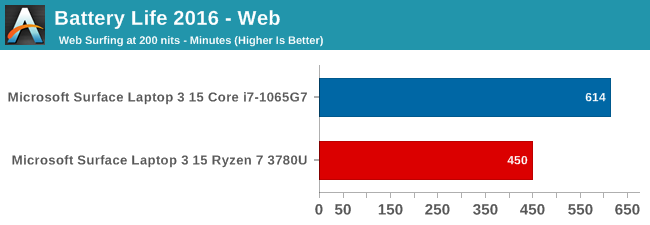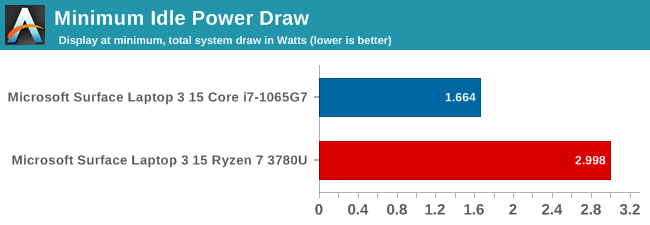The Microsoft Surface Laptop 3 Showdown: AMD's Ryzen Picasso vs. Intel's Ice Lake
by Brett Howse & Andrei Frumusanu on December 13, 2019 8:30 AM ESTPlatform Power
Performance aside, the other side of the coin is battery life. AMD made big gains in battery life with the Ryzen 3000 series, somewhat addressing the power requirements of the platform and getting rid of some of the excessive idle power draw, but they are still using DDR4 on their mobile platform, which puts them at a disadvantage right out of the gate. Intel has made very good gains in battery life over the last several generations, and the move to 10 nm for Ice Lake also brought along LPDDR4X support. Most of the previous generation laptops stuck with LPDDR3, unless the manufacturer needed more than 16 GB of RAM, where they’d be forced to switch to DDR4. Finally adding LPDDR4X support is something that Intel has needed to do for a while, and ironically Intel’s flagship Core product line lagged behind their low-cost Atom lineup which did support LPDDR4.
Web Battery Life

The Ryzen 7 3780U powered Surface Laptop 3 was slightly under the Ryzen 5 device we tested at launch, but still in the same range. The AMD system isn’t helped very much by Microsoft only offering a 46 Wh nominal battery capacity, which is rather undersized for a 15-inch laptop. The Ice Lake device, as we’ve seen before, was much more efficient under load, offering a sizeable battery life lead.
Idle Power
One of AMD’s biggest challenges was to get their laptop SoC into a premium device, and with the Surface Laptop 3 they have succeeded. Microsoft has shown themselves as being adept at squeezing battery life out of devices, with low-power displays, and good internal components to minimize power draw. Here Intel has held a considerable advantage over the last couple of years, and the move to 10 nm should, in theory, help as well.
To test the idle power draw of both systems, the battery discharge rate was monitored with the screens fixed in at 5.35 nits, to minimize the power draw of the display on the result. Normally we’d prefer to have the display completely off for this test, but Microsoft’s power plan on the Surface Laptop actively turns off the laptop when the display times out.

The Ice Lake system was able to go all the way down to right around 2 Watts of power draw – and sometimes slightly under – with as low as 1.7 Watts seen. We’ve seen under 1 Watt of draw on an 8th generation Core Y series processor, and around 1.5 Watts on the same generation U series, so considering the display is not completely off on the Surface Laptop, the 2-Watt draw is quite reasonable.
The Picasso system was not quite as efficient, drawing 3 Watts at idle. This is in-line with the results we’ve seen on other Picasso systems and explains the lower battery life results on the AMD system. AMD made big gains moving from Raven Ridge to Picasso, but I’m sure the team is looking forward to the 7 nm Zen 2 coming to their laptops, which we hope will address this further.










174 Comments
View All Comments
MBarton - Monday, December 30, 2019 - link
There's a lot more money in server and retail desktop CPU's than there are in sub-$1000 mobile parts. Why would AMD send perfect good Zen 2 cores to the mobile market if they can sell them as something with better margins?Teckk - Friday, December 13, 2019 - link
There's no way to recommend an AMD laptop yet. Intel has all the numbers both in terms of performance and in terms of the various models by different OEMs. Lot to catch up for AMD. This market is Intel's to lose and by the looks of the integrated graphics in this, seems to be a tough task for AMD.5080 - Friday, December 13, 2019 - link
Zen 2 based APU's (Renoir) will easily catch up to Intel's mobile CPU lineup. We can assume that graphics and storage performance will be much better since NVMe can use the PCIe 4.0 bus and AMD's iGPU was always ahead of Intel. We will know soon since AMD is scheduled to release Renoir on CES in January. Microsoft should have waited for Renoir before putting it into its Surface.smilingcrow - Friday, December 13, 2019 - link
Looking at the current high power draw of PCIe 4.0 I can't see it being attractive for mobile just yet, especially as battery life is generally more important than 5GB/s storage speeds in laptops.GreenReaper - Friday, December 13, 2019 - link
If you can use half the lanes I can totally see it being attractive - just as a quad-core may use less power than an octa-core. The main issue on the desktop is wanting the same number of faster lanes.MBarton - Monday, December 30, 2019 - link
Exactly. AMD showing up with Zen 2 and x570's PCIe 4.0 wouldn't have carried much weight if they sacrificed lane count in the process.RSAUser - Friday, December 13, 2019 - link
It doesn't pull the full required power at all times, it's fine for burst.Still think it doesn't really make sense though as you don't need the speed in any laptops right now as no drive can properly max it.
RSAUser - Friday, December 13, 2019 - link
Storage speed is relative, most would not notice the speedup.MASSAMKULABOX - Sunday, December 15, 2019 - link
Anybody care to mak any predictions on how much better the rRenoir Igpu will be compared to the 2400/3400g .. I'm thinking maybe a 25% uplift but maybe more it its NAVI. However everyone seems to be foregtting they have done most of the work , in getting out the Head Canyon NUC for Intel. they can announce in Jan with general avail in 2,3,6 months ??scineram - Monday, December 16, 2019 - link
No.